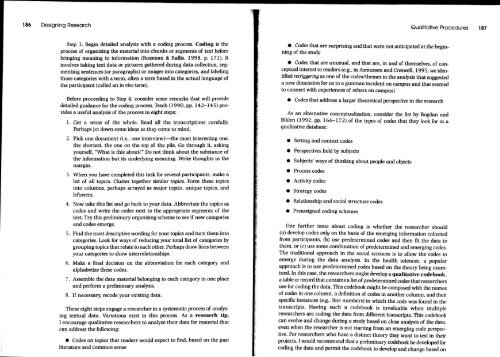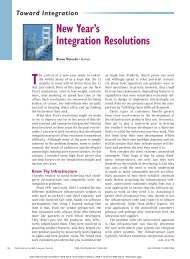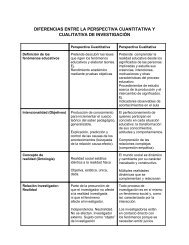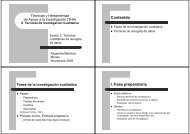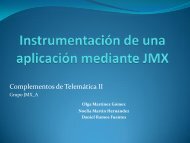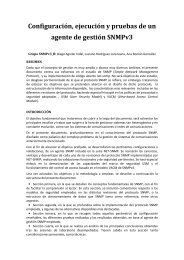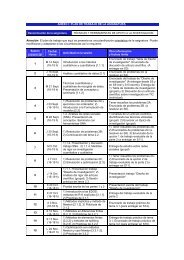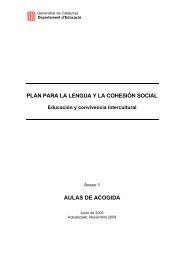Research Questions and Hypotheses
Research Questions and Hypotheses
Research Questions and Hypotheses
Create successful ePaper yourself
Turn your PDF publications into a flip-book with our unique Google optimized e-Paper software.
186 Designing <strong>Research</strong> Qualitative Procedures 187<br />
Step 3. Begin detailed analysis with a coding process. Coding is the<br />
process of organizing the material into chunks or segments of text before<br />
bringing meaning to information (Rossman & Rallis, 1998, p. 171). It<br />
involves taking text data or pictures gathered during data collection, segmenting<br />
sentences (or paragraphs) or images into categories, <strong>and</strong> labeling<br />
those categories with a term, often a term based in the actual language of<br />
the participant (called an in vivo term).<br />
Before proceeding to Step 4, consider some remarks that will provide<br />
detailed guidance for the coding process. Tesch (1990, pp. 142-145) provides<br />
a useful analysis of the process in eight steps:<br />
Get a sense of the whole. Read all the transcriptions carefully.<br />
Perhaps jot down some ideas as they come to mind.<br />
Pick one document (Le., one interview)—the most interesting one,<br />
the shortest, the one on the top of the pile. Go through it, asking<br />
yourself, "What is this about?" Do not think about the substance of<br />
the informatiori but its underlying meaning. Write thoughts in the<br />
margin.<br />
When you have completed this task for several participants, make a<br />
list of all topics. Cluster together similar topics. Form these topics<br />
into columns, perhaps arrayed as major topics, unique topics, <strong>and</strong><br />
leftovers.<br />
Now take this list <strong>and</strong> go back to your data. Abbreviate the topics as<br />
codes <strong>and</strong> write the codes next to the appropriate segments of the<br />
text. Try this preliminary organizing scheme to see if new categories<br />
<strong>and</strong> codes emerge.<br />
Find the most descriptive wording for your topics <strong>and</strong> turn them into<br />
categories. Look for ways of reducing your total list of categories by<br />
grouping topics that relate to each other. Perhaps draw lines between<br />
your categories to show interrelationships.<br />
Make a final decision on the abbreviation for each category <strong>and</strong><br />
alphabetize these codes.<br />
Assemble the data material belonging to each category in one place<br />
<strong>and</strong> perform a preliminary analysis.<br />
8. If necessary, recode your existing data.<br />
These eight steps engage a researcher in a systematic process of analyzing<br />
textual data. Variations exist in this process. As a research tip,<br />
I encourage qualitative researchers to analyze their data for material that<br />
can address the following:<br />
Codes on topics that readers would expect to find, based on the past<br />
literature <strong>and</strong> common sense<br />
Codes that are surprising <strong>and</strong> that were not anticipated at the beginning<br />
of the study<br />
Codes that are unusual, <strong>and</strong> that are, in <strong>and</strong> of themselves, of conceptual<br />
interest to readers (e.g., in Asmussen <strong>and</strong> Creswell, 1995, we identified<br />
retriggering as one of the codes/themes in the analysis that suggested<br />
a new dimension for us to a gunman incident on campus <strong>and</strong> that seemed<br />
to connect with experiences of others on campus)<br />
Codes that address a larger theoretical perspective in the research<br />
As an alternative conceptualization, consider the list by Bogdan <strong>and</strong><br />
Biklen (1992, pp. 166-172) of the types of codes that they look for in a<br />
qualitative database:<br />
Setting <strong>and</strong> context codes<br />
Perspectives held by subjects<br />
Subjects' ways of thinking about people <strong>and</strong> objects<br />
Process codes<br />
Activity codes<br />
Strategy codes<br />
Relationship <strong>and</strong> social structure codes<br />
Preassigned coding schemes<br />
One further issue about coding is whether the researcher should<br />
(a) develop codes only on the basis of the emerging information collected<br />
from participants, (b) use predetermined codes <strong>and</strong> then fit the data to<br />
them, or (c) use some combination of predetermined <strong>and</strong> emerging codes.<br />
The traditional approach in the social sciences is to allow the codes to<br />
emerge during the data analysis. In the health sciences, a popular<br />
approach is to use predetermined codes based on the theory being examined.<br />
In this case, the researchers might develop a qualitative codebook,<br />
a table or record that contains a list of predetermined codes that researchers<br />
use for coding the data. This codebook might be composed with the names<br />
of codes in one column, a definition of codes in another column, <strong>and</strong> then<br />
specific instances (e.g., line numbers) in which the code was found in the<br />
transcripts. Having such a codebook is invaluable when multiple<br />
researchers are coding the data from different transcripts. This codebook<br />
can evolve <strong>and</strong> change during a study based on close analysis of the data,<br />
even when the researcher is not starting from an emerging code perspective.<br />
For researchers who have a distinct theory they want to test in their<br />
projects, I would recommend that a preliminary codebook be developed for<br />
coding the data <strong>and</strong> permit the codebook to develop <strong>and</strong> change based on


